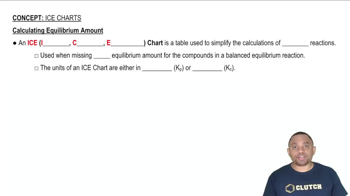Consider the reaction: SO2Cl2(g) ⇌ SO2(g) + Cl2(g) Kc = 2.99⨉10-7 at 227 °C If a reaction mixture initially contains 0.175 M SO2Cl2, what is the equilibrium concentration of Cl2 at 227 °C?
Ch.15 - Chemical Equilibrium
Chapter 15, Problem 62
Consider the reaction: A(g) ⇌ 2B(g). Find the equilibrium partial pressures of A and B for each value of Kp. Assume that the initial partial pressure of B in each case is 1.0 atm and that the initial partial pressure of A is 0.0 atm. Make any appropriate simplifying assumptions. a. Kp = 1.0 b. Kp = 1.0 × 10^-4 c. Kp = 1.0 × 10^5.
 Verified step by step guidance
Verified step by step guidance1
insert step 1
insert step 2
insert step 3
insert step 4
insert step 5
Key Concepts
Here are the essential concepts you must grasp in order to answer the question correctly.
Chemical Equilibrium
Chemical equilibrium occurs when the rates of the forward and reverse reactions are equal, resulting in constant concentrations of reactants and products. In this case, the reaction A(g) ⇌ 2B(g) reaches a state where the partial pressures of A and B remain unchanged over time. Understanding this concept is crucial for analyzing how changes in conditions affect the equilibrium position and the concentrations of the species involved.
Recommended video:
Guided course

Chemical Equilibrium Concepts
Equilibrium Constant (Kp)
The equilibrium constant, Kp, is a dimensionless value that expresses the ratio of the partial pressures of products to reactants at equilibrium, raised to the power of their stoichiometric coefficients. For the reaction A(g) ⇌ 2B(g), Kp is calculated as Kp = (P_B^2) / (P_A). Different values of Kp indicate the extent to which the reaction favors products or reactants, which is essential for determining the equilibrium partial pressures in this scenario.
Recommended video:
Guided course

Equilibrium Constant Expressions
ICE Table (Initial, Change, Equilibrium)
An ICE table is a systematic way to organize the initial concentrations (or partial pressures), the changes that occur as the system reaches equilibrium, and the equilibrium concentrations. For the given reaction, the initial pressures of A and B, the changes in their pressures as the reaction proceeds, and the final equilibrium pressures can be calculated using this table. This method simplifies the process of solving for unknowns in equilibrium problems.
Recommended video:
Guided course

ICE Charts and Equilibrium Amount
Related Practice
Textbook Question
1
views
Textbook Question
Consider the reaction: A(g) ⇌ B(g) + C(g) Find the equilibrium concentrations of A, B, and C for each value of Kc. Assume that the initial concentration of A in each case is 1.0 M and that the reaction mixture initially contains no products. Make any appropriate simplifying assumptions. b. Kc = 0.010
1
views
Textbook Question
Consider this reaction at equilibrium: 2 BrNO(g) ⇌ 2 NO(g) + Br2(g) Predict whether the reaction will shift left, shift right, or remain unchanged after each disturbance. a. NO is added to the reaction mixture.
Textbook Question
Consider this reaction at equilibrium: 2 BrNO(g) ⇌ 2 NO(g) + Br2(g) Predict whether the reaction will shift left, shift right, or remain unchanged after each disturbance. b. BrNO is added to the reaction mixture.
